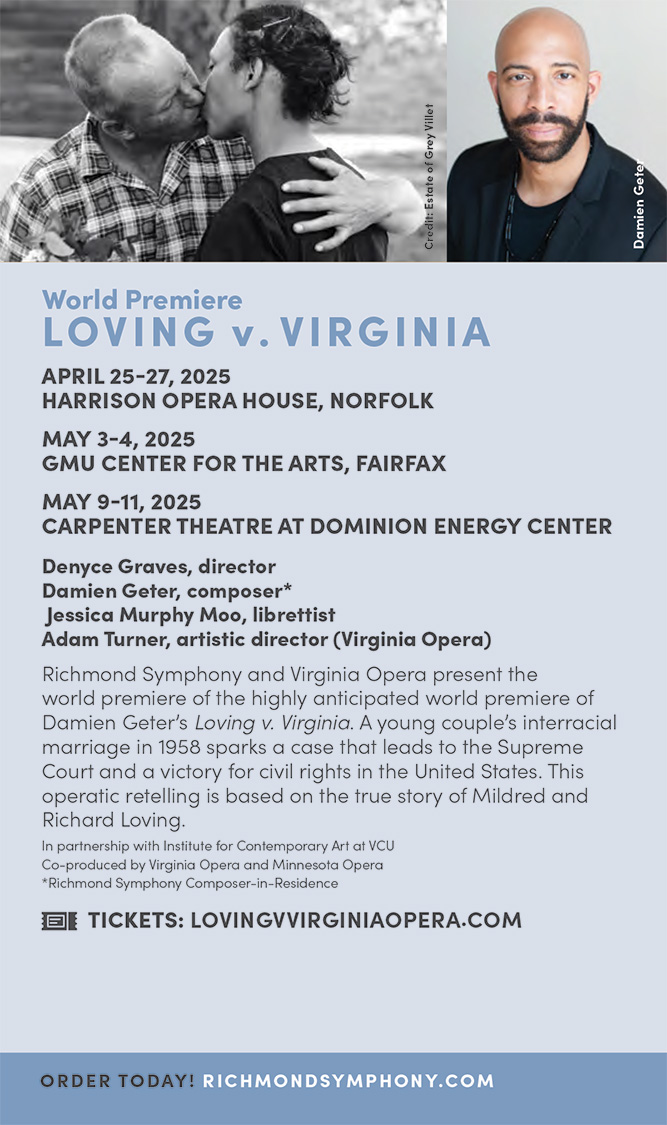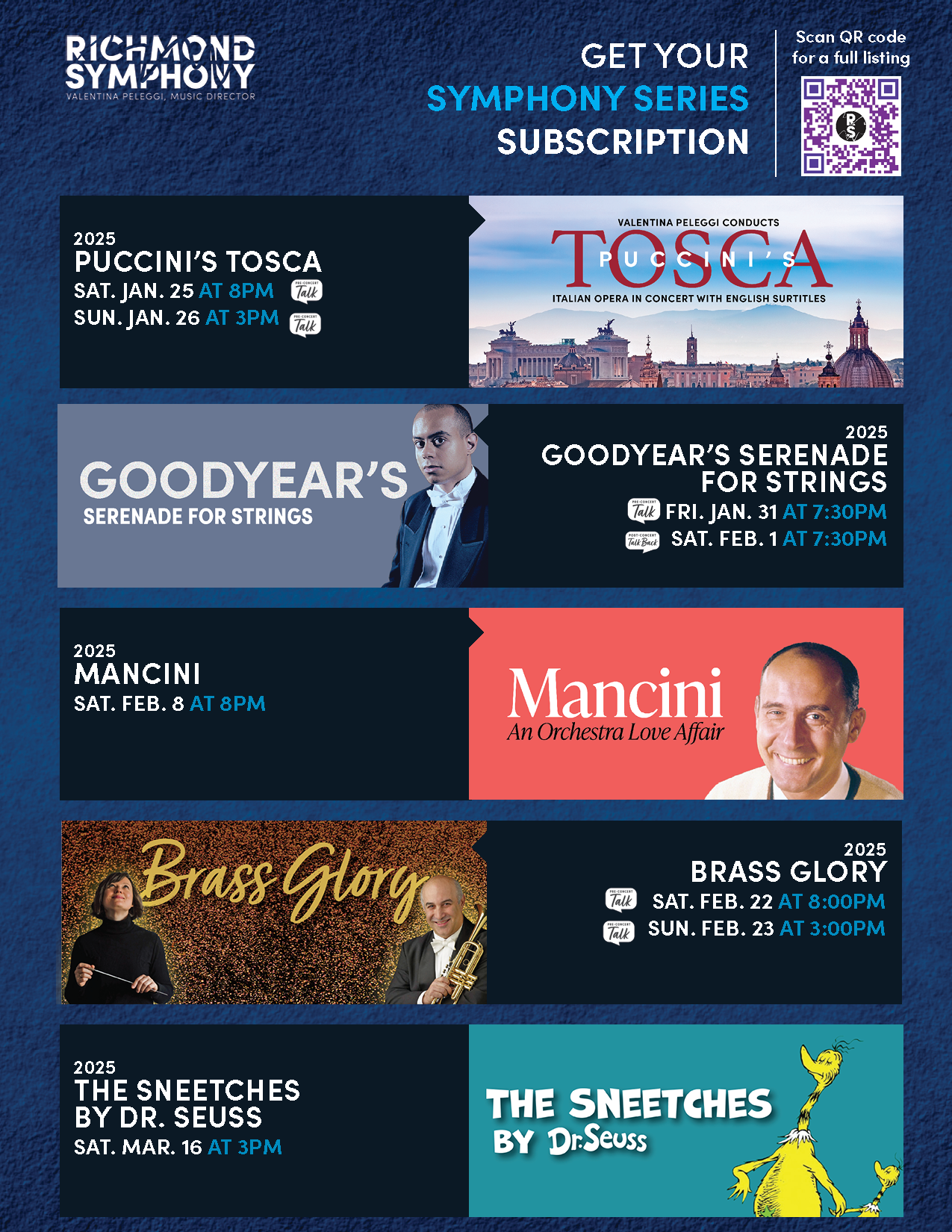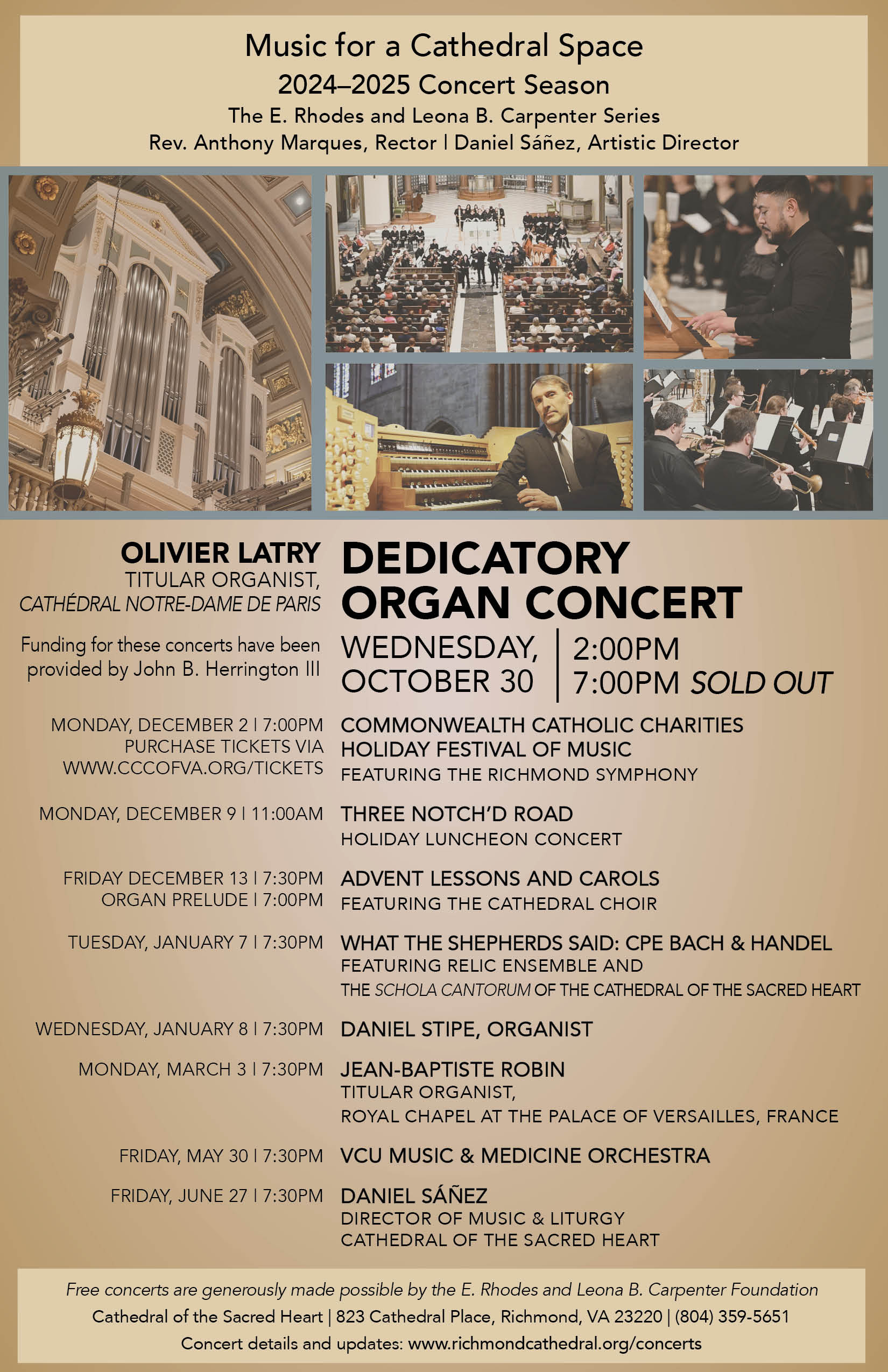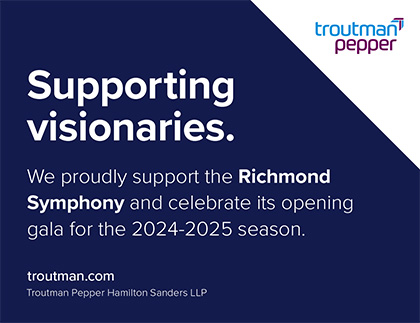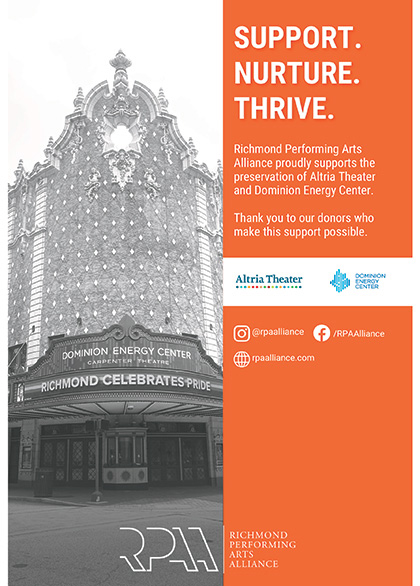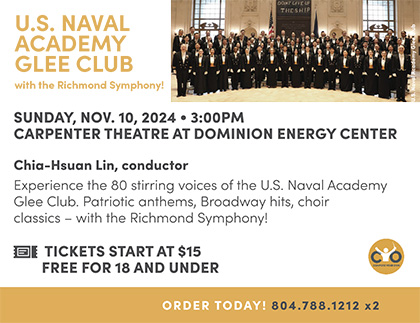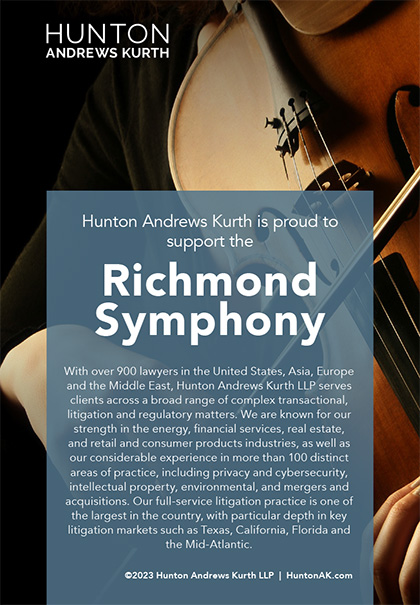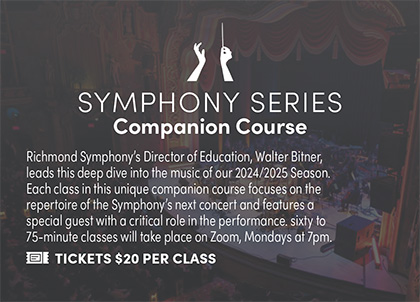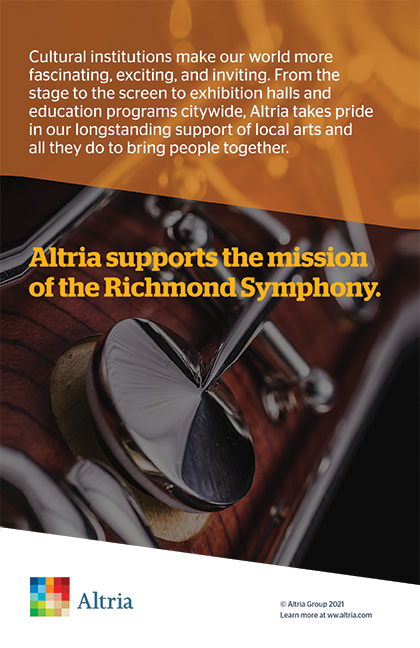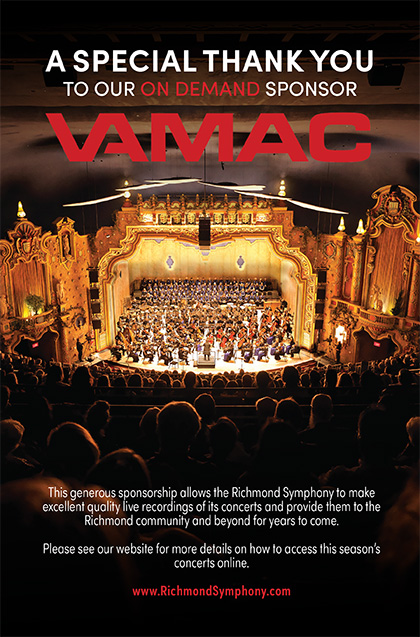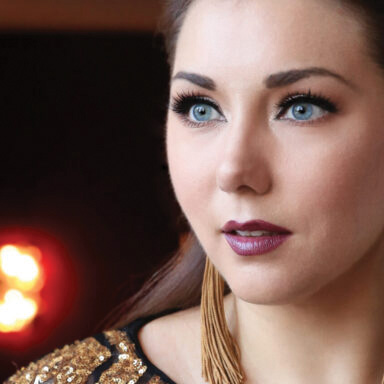
PUCCINI’S TOSCA
Valentina Peleggi | Conductor | Jennifer Rowley | SOPRANO (Tosca) Richmond Symphony Chorus Greater Richmond Children’s Choir |

Music by Giacomo Puccini | Opera in the acts in Italian
Libretto by Luigi Illica and Giuseppe Giacosa
Conductor - Valentina Peleggi
Director - Michelle Harman Gulick
Floria Tosca - Jennifer Rowely
Mario Cavaradossi - John Matthew Myers
Baron Scarpia - Lester Lynch
Cesare Angelotti - Andrew Potter
Spoletta - Will Fercuson
Richmond Symphony Chorus
Chorus Director - Richard Robbins
Greater Richmond Children’s Choir
Artistic Director - Crystal Jonkman
By presenting Tosca as part of the Richmond Symphony season, Music Director Valentina Peleggi hopes to give audiences an opportunity to experience one of the most frequently performed operas in the repertoire with fresh ears. “Usually, the instrumentation has to be cut when Virginia Opera performs Tosca because of the size limitations of the theater pit,”
she explains.
Onstage in the Carpenter Theatre, however, all of the intricate details and orchestral colors of Puccini’s powerful score can be savored to the full. “For once, the audience can focus on the music in its full instrumentation and be immersed in this lush score, which is sometimes passionate and sometimes scary,” says Peleggi.
“Instead of just waiting for the big, lyrical moments in the arias, they’ll be able to pay more attention to the symphonic side of Puccini’s score — to the way he weaves his motifs together to tell the story.”
Italy has long been under the domination of the Hapsburg dynasty. Napoleon Bonaparte, however, has emerged as a threat to the status quo, and Rome is in chaos, without a clear ruler. Baron Scarpia, the chief of police, has become the highest authority. Loyal to the king and queen of Naples, Scarpia seeks to eliminate any remaining trace of Napoleon’s attempts to establish a secular Roman Republic.
Act one: The Church of Sant’Andrea della Valle
Cesare Angelotti, a Republican political prisoner, has just escaped from the Castel Sant’Angelo, where he had been placed by Scarpia. Angelotti’s sister, the Marchesa Attavanti, has hidden a disguise for him in the church, where the painter Mario Cavaradossi is working on a painting of Mary Magdalene with the begrudging help of the sacristan. Cavaradossi takes as his inspiration both the Marchesa, whom he has recently seen at prayer, and his beloved Floria Tosca, a prominent opera singer (Aria: Recondita armonia). He recognizes Angelotti and promises to help him escape, but is surprised by a visit from Tosca.
Angelotti hides while Cavaradossi attempts a quick conversation with her (Duet: Perchè chiuso?(. Tosca is instantly suspicious of Cavaradossi’s cautious behavior and jealous of the woman she sees represented in his painting. Cavaradossi assuages her fears and they make plans to spend the evening together. No sooner has Tosca gone than a cannon shot signals that Angelotti’s escape has been discovered. He and Cavaradossi depart immediately for Cavaradossi’s villa.
The sacristan returns with news of Napoleon’s defeat by the Austrians. Arrangements have been made for an immediate celebration and a concert at the Palazzo Farnese, featuring Floria Tosca. Baron Scarpia, who has come in search of Angelotti, interrupts the preparation. Scarpia and his spies find an empty basket of food and a woman’s fan bearing the Attavanti family crest. When Tosca returns to see Cavaradossi, her jealousy is again aroused by his absence. Scarpia preys on her suspicions by showing her the Marchesa’s fan. After she leaves, Scarpia orders his agent Spoletta to follow her. As the congregation assembles for the Te Deum, Scarpia plans to eliminate Cavaradossi and possess Tosca for himself.
Intermission
Act two: Baron Scarpia’s apartment in the Palazzo Farnese
Scarpia relishes his plan to execute the traitors and seduce Tosca. When Cavaradossi is brought for questioning, the painter denies any knowledge of Angelotti’s location. At Scarpia’s request, Tosca arrives from the victory celebrations. Cavaradossi is then taken to an adjoining room and tortured. His agonized cries force Tosca to divulge Angelotti’s hiding place – the well in the garden of Cavaradossi’s villa. The tortures cease; Tosca and Cavaradossi are briefly reunited before Scarpia orders Spoletta to Angelotti’s hiding place. As Cavaradossi denounces Tosca for her betrayal, news arrives that Napoleon has actually defeated the Austrians at Marengo. Cavaradossi predicts greater and greater victory for the Republicans, and Scarpia orders him taken away for execution.
When Tosca pleads for mercy, Scarpia makes his price clear: she can buy Cavaradossi’s life by giving herself to Scarpia (Aria: Già mi dicon venal). After wondering how God can choose to punish her this way (Aria: Vissi d’arte), she reluctantly agrees. Since Scarpia has ordered Cavaradossi’s death, a mock execution must be arranged, and he seems to give this order to Spoletta. Tosca makes one further request: a warrant of safe passage so that she and Cavaradossi can leave the country. This done, Scarpia advances to embrace her, and she stabs him to death.
INTERMISSION
Act three: The roof of the Castel Sant’Angelo
The distant song of a passing young shepherd and church bells tolling indicate the approaching dawn. Cavaradossi is brought into the castle yard to prepare for his death, and his thoughts turn to Tosca. He is attempting to write a final letter to her (Aria: E lucevan le stelle) when she appears. She shows him the warrant of safe passage, explains the mock execution, and describes how she killed Scarpia.
Tosca and Cavaradossi dream of their future happiness together (Duet: Amaro sol per te m’era morire). As the soldiers assemble for the execution, Tosca instructs Cavaradossi to feign his death and remain motionless until she can confirm it is safe to leave. After the soldiers depart, she discovers she has been betrayed: Cavaradossi is dead. Spoletta and his men attempt to arrest Tosca for Scarpia’s murder, but she is too quick for them. Vowing to confront Scarpia before God, she takes her own life.
— John Caird
Reprinted courtesy of Houston Grand Opera.
In Tosca, Italy is under Hapsburg rule, with Napoleon threatening the status quo. Rome is in chaos, and Baron Scarpia, the ruthless chief of police, seeks to crush any remnants of the Roman Republic.
Act One: In the Church of Sant’Andrea della Valle, Cesare Angelotti, an escaped political prisoner, hides with the help of painter Mario Cavaradossi, who is working on a portrait inspired by his lover, Tosca. When Tosca arrives, she grows jealous over the painting. After she leaves, Angelotti and Cavaradossi flee as Scarpia begins searching for Angelotti, using Tosca’s jealousy to manipulate her.
Act Two: In Scarpia’s apartment, Cavaradossi is tortured for Angelotti’s whereabouts, forcing Tosca to reveal the secret. Scarpia offers Tosca a bargain: Cavaradossi’s life in exchange for her submission. Tosca reluctantly agrees but stabs Scarpia after securing a mock execution and safe passage for herself and Cavaradossi.
Act Three: On the Castel Sant’Angelo’s rooftop, Tosca tells Cavaradossi about Scarpia’s murder and the plan for his fake execution. However, after the execution, Tosca realizes the betrayal: Cavaradossi is truly dead. Cornered by Scarpia’s men, she takes her own life, vowing to face Scarpia in the afterlife.
— John Caird
Reprinted courtesy of Houston Grand Opera.
Puccini’s Source
In 1887, La Tosca, a drama by Victorien Sardou, became a sensation. While the play has faded into obscurity, Puccini’s opera Tosca, based on it, remains immensely popular. Puccini recognized the opera potential in La Tosca after seeing it in Italy in 1889. Though initially unable to secure the rights, Puccini persisted, and in 1895, as he finished La Bohème, he reacquired the rights to La Tosca with the help of librettists Luigi Illica and Giuseppe Giacosa. Their collaboration was difficult, but after years of effort, Tosca premiered in Rome on January 14, 1900.
Musical Realism
Sardou’s original play emphasized historical accuracy, depicting corrupt state power and the Catholic Church as oppressive. While Sardou paid less attention to Rome’s geography, Puccini focused on precise local details. He worked to create musical realism, consulting experts to replicate sounds such as the bell of St. Peter’s and incorporating authentic Roman chants. For Puccini, Rome itself became a character in the opera, embodying both the grandeur and intrigue of the city’s history.
An Operatic Thriller
Puccini’s Tosca is more than a simple adaptation; it is an operatic thriller. Sardou’s “well-made” play provided a tight plot for Puccini, whose music heightens the urgency of the drama. The opera’s action unfolds in a single day, and Puccini’s score, with its recurring thematic ideas, drives the tension. Tosca is more dissonant than Puccini’s earlier works, with orchestration and tempo often pushed to extremes.
Puccini distilled Sardou’s sprawling play, focusing on key moments such as the electrifying first act finale, where Scarpia’s sinister obsession with Tosca is juxtaposed against a grand church celebration. Another striking example is the beginning of the third act, where a serene dawn contrasts with the impending execution of Cavaradossi.
The score balances lyrical beauty with the relentless pace of the narrative. Tosca’s famous aria “Vissi d’arte,” nearly cut for halting the action, instead offers a profound interior monologue. This psychological realism is central to Puccini’s verismo style, where human emotions and passions are explored with intense
dramatic impact.
Scarpia, the opera’s villain, is musically characterized from the outset. His presence is felt through three ominous chords that recur throughout the opera, symbolizing his pervasive influence. Unlike the lyrical lines given to the lovers, Scarpia’s music is harsh and manipulative, reflecting his evil intelligence and control over others.
Puccini’s Musical Characterization
Cavaradossi’s revolutionary ideals are more muted in the opera than in the play. Instead, he is portrayed as a sensitive artist, whose first aria, “Recondita armonia,” reflects his view of the world through art. His character remains noble, but it is Tosca who undergoes the most significant transformation.
Tosca, a celebrity opera singer, is compelled by Scarpia’s corrupt power to make tragic choices. Her signature aria, “Vissi d’arte,” reflects her disillusionment as she realizes that her life devoted to art cannot protect her from the harsh realities of power and manipulation. Puccini’s music contrasts the lyrical beauty of Tosca’s world with the violent forces closing in on her.
In the final act, Tosca tries to save Cavaradossi, but the lovers’ reunion is brief. Puccini’s music conveys both the intensity of their love and the inevitability of tragedy. Tosca’s leap to her death, as she escapes Scarpia’s minions, is as abrupt as it is dramatic. Yet, the opera ends not with violence but with a poignant melody, as Cavaradossi’s final aria, “E lucevan le stelle,” evokes the beauty of life, now lost.
(c)2024 Thomas May
Tenor | Bass |
